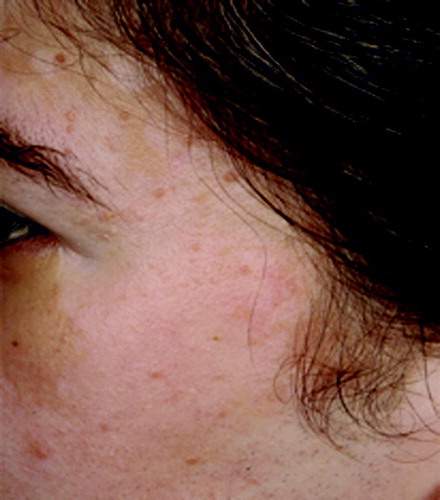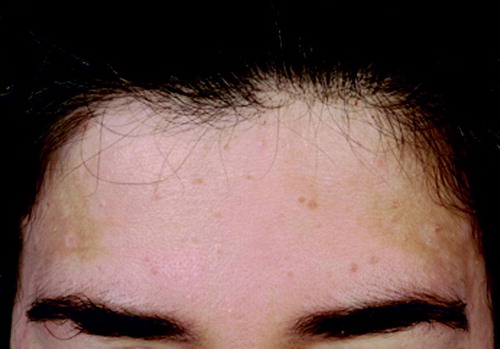To the Editor
we present a case of clinical ingenuity and importance of multidisciplinary approach to diagnose a rare disorder. A young female in her twenties presented to dermatologist for relatively insignificant facial papular lesion ( and ), which was removed on more than five occasions. Histology of the lesion had appearance of tricholemommas, creating suspicion in the probing dermatologist's mind of Cowden Syndrome (CS), a rare inherited cancer predisposing disease of estimated incidence of one in 200 000. She was referred to a clinical genetician, who also noted acral keratosis affecting feet and macrocephaly, two more diagnostic signs of CS. She was further investigated for carcinoma of breast, thyroid and endometrium. She was found to have thyroid nodule awaiting needle biopsy and uterine fibroid. Triple assessment of breast has excluded breast cancer at present, but she is on annual surveillance. She now has almost certain diagnosis of CS based on Diagnostic criteria for Cowden syndrome (International Cowden consortium 2000) (). Her preliminary results of testing for the PTEN (phosphtase and tensin homolog) gene showed no mutation in coding exons. The promoter region is being looked at, which represent 10% of mutations
Table I. Diagnostic criteria for Cowden syndrome (international Cowden consortium 2000) Citation[1]1.
Cowden's syndrome is an autosomal dominant disorder involving PTEN, a tumour suppressor gene on 10q23.3 that regulates cell cycle arrest and/or apoptosis. Mutation in the PTEN suppressor gene is seen in 80% of CS and in the remaining 20% cases the genetic causes remain undetermined Citation[3]. It is characterized by multiple hamartomatous lesions of the skin, mucous membranes, breast and thyroid. Multiple trichilemommas are pathognomonic. It most commonly includes fibrocystic disease of the breast, fibroadenoma, nipple discharge, virginal hypertrophy of the breast, thyroid adenomas, polyps of the gastrointestinal tract, ovarian cysts and uterine fibroids.
There is an increased risk of developing cancer in patients with CS especially involving breast, thyroid and gastrointestinal tract. The lifetime risk of women developing breast cancer with CS is as high as 50%, affecting young women (average age 38 years) with a third of them involving both breasts Citation[4]. There is evidence that bilateral prophylactic mastectomy reduces the risk of a women developing breast cancer by approximately 90% Citation[2], Citation[5]. Other cancer predisposition includes thyroid cancers and less commonly gastrointestinal and renal cell carcinomas.
Patients with CS are advised regular annual follow-up for a clinical examination and a mammogram, ultrasound scan of thyroid and pelvis, urinary cytology and gastrointestinal endoscopies to detect cancer.
She is the first reported case on CS in Wales. This case report re-emphasizes the importance of a multidisciplinary approach and high degree of clinical suspicion at level of individual clinician in diagnosing the rare potentially life threatening condition.
References
- Eng C. Will the real Cowden syndrome please stand up?: Revised diagnostic criteria. J Med Genet 2000; 37: 828–30
- Walton BJ, Morain WD, Baughman RD, Jordan A, Crichlow RW. Cowden's disease: A further indication for prophylactic mastectomy. Surgery 1986; 99: 82–6
- Pilarski R, Eng C. Will the real Cowden syndrome please stand up (again)? Expanding mutational and clinical spectra of PTEN hamartoma tumour syndrome. J Med Genet 2004; 41: 323–6
- Starink TM, van der veen JPW, Arwert F, et al. The Cowden syndrome: A clinical and genetic study in 21 patients. Clin Genet 1986; 29: 222–33
- Hartmann LC, Schaid DJ, Woods JE, Crotty TP, Myers JL, Arnold PG, et al. Efficacy of bilateral prophylactic mastectomy in women with a family history of breast cancer. N Engl J Med 1999; 340: 77–84

